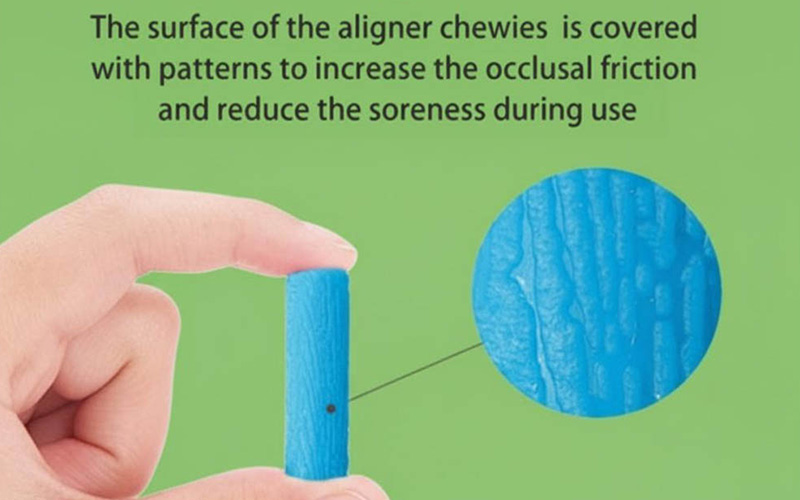
A Dentist’s Guide to Integrating Silicone Chewies for Patient Success
Hello there. For years, I’ve worked as a dentist, helping hundreds of people get the smile they’ve always dreamed of. Many of my patients choose Invisalign for its clear, comfortable design. But I have a little secret I share with all of them, a simple tool that can make a huge difference in their treatment. It’s the humble Invisalign chewie.
You may have gotten a small pack of these with your first set of trays and wondered what they were for. In this article, I’m going to pull back the curtain on these amazing little helpers. I’ll show you exactly why they are so important for anyone using Invisalign. We will talk about how they work, the right way to use them, and how they can help you get better results, faster. If you want your invisalign treatment to be as smooth and effective as possible, this guide is for you.
Table of Contents
What Exactly Are Invisalign Chewies?
So, what is this little tool I’m talking about? You may have heard them called a few different names: aligner chewies, aligner tray seaters, or just seaters. No matter the name, they all do the same important job. Invisalign chewies are small, soft objects that you chew on after putting in your aligners. They look like a small foam or rubber roll.
Most invisalign chewies are a small cylinder shape and are made of soft plastic or a spongy material called silicone. They are firm but still soft enough to bite on without any pain. Think of them as a small cushion for your teeth. When you get your first aligner, your orthodontist or dentist will likely give you a couple to get started. They are a key part of making your invisalign treatment a success.
These tools are designed specifically for your orthodontic journey. Their main purpose is to help your aligner fit perfectly over your teeth. This perfect fit is what makes the whole system work. The chewie provides a soft, even surface to bite on. This helps your aligner snap into place, exactly where it needs to be to do its job.

Why Should I Use Chewies with My Invisalign Aligner?
I get this question all the time from my patients. They put in their new aligner tray, and it feels tight. They think, “Isn’t that enough?” The simple answer is no. Using invisalign chewies is a vital step. Chewies help ensure your aligners fit correctly. When an aligner is not seated all the way, you can get small spaces between your teeth and the plastic. We call these air gaps.
These air gaps mean your aligner is not making full contact with your teeth. If there is no contact, the aligner cannot apply the right pressure to move your teeth. This can slow down your progress. Invisalign chewies help you close those gaps. They make sure the invisalign aligner is pressed snugly against every tooth. This improves the fit of your aligners and makes your treatment much more effective. I always tell my patients that a few minutes with a chewie each day can save them weeks of extra treatment time.
Think of your aligner like a key for a lock. If the key isn’t pushed in all the way, the lock won’t turn. In the same way, if your aligner isn’t seated all the way, your teeth won’t move the way they are supposed to. Chewies help your aligners fit perfectly, ensuring the key is all the way in the lock. This is how aligners fit better and do their job right. Using invisalign chewies helps get rid of those pesky air gaps between the aligners and your teeth.
How Do Aligner Chewies Actually Work to Speed Up Treatment?
This is where the magic happens. It might seem too simple, but the science behind it is solid. Your clear aligners work by applying steady, gentle force to your teeth. This force is what guides them into their new, straight positions. For this to work, the aligner has to grip each tooth just right. The use of chewies can help make this happen.
When you bite down on a chewie, you apply gentle pressure. This pressure is spread out across your teeth. It helps to help seat the aligner tray firmly and evenly. This action removes any tiny spaces between the teeth and the aligner. This ensures that the forces built into the aligner are transferred directly to your teeth. When your teeth get this steady pressure, they teeth move more predictably. This can help you stay on schedule with your invisalign treatment plan. A better fit often leads to faster results. That’s how a simple chewie can help speed up treatment.
I’ve seen it myself in my practice. Patients who are diligent about using their invisalign chewies often track better with their orthodontic plan. This means they can switch to their next aligner on time without any issues. Chewies may also help stimulate blood flow in the gums around your teeth. Some dental experts believe this can help make tooth movement a bit more comfortable. It’s a simple step that can help improve your entire experience.
What’s the Right Way to Use Invisalign Chewies? A Step-by-Step Guide
Using a chewie is easy, but it’s important to use them correctly. I give my patients this simple routine to follow. It only takes a few minutes, but it makes a world of difference. You should use chewies every time you put your aligners back in your mouth. This is especially true after eating or brushing your teeth.
Here is a simple guide to follow:
- Put In Your Aligner: First, put your clean aligner trays onto your teeth. Push them down with your fingers as you normally would.
- Position the Chewie: Place one between your teeth. I tell my patients to start on one side of their mouth with the back molars.
- Bite and Hold: Bite down gently on the chewie. Hold the pressure for a few seconds. You should feel the aligner seating more tightly against your teeth.
- Move It Around: Don’t just chew in one spot. Slowly move it around to different areas of your mouth. Work your way from the back teeth on one side all the way to the back teeth on the other. Make sure you bite down with your front teeth, too.
- Focus on Gaps: If you see any visible air gaps, spend a little extra time biting on the chewie in that area. This will help position your aligner correctly. The goal is to get even pressure across all teeth.
Doing this for 5 to 10 minutes a day is a great goal. This simple exercise will help you seat your aligners properly and get the most out of your standard invisalign journey.
How Often Should I Use Chewies During My Invisalign Treatment?
Consistency is key when it comes to your invisalign treatment. The more you wear your aligners, the better they work. The same is true for using invisalign chewies. The best results come from using them regularly. I advise my patients to make it part of your daily routine. A great time to use chewies is right after you put your aligners in for the night.
I recommend you use invisalign chewies for about 5-10 minutes each day. You can break this up into a few short sessions. For example, you could use them for a couple of minutes every time you put your aligners back in your mouth after a meal. This is especially important when you switch to a new aligner tray. The new aligner will be the tightest, and a chewie can help it settle into place.
Of course, you should always follow the advice given to you by your orthodontist or dentist. They know your specific dental needs. They might give you a different schedule based on your treatment plan. If they tell you to use them more or less often, be sure to follow their directions. Remember, every patient is unique, so always listen to what your doctor says when instructed by your orthodontist.

Do These Aligner Tray Seaters Really Make a Difference?
Absolutely, yes! In my years as an invisalign dentist, I can tell the difference between patients who use their aligner tray seaters and those who don’t. The ones who use them often have a better overall experience. Their aligners track better, meaning the teeth are moving exactly as planned. This helps keep your treatment on track.
Chewies make the invisalign chewies improve the fit of the aligner. A better fit means more comfort. When an aligner isn’t seated well, it can have sharp edges that rub against your cheeks or tongue. Using a chewie to press the aligner snugly against your teeth can reduce this irritation. Also, chewies can reduce the chance of needing a “refinement” at the end of your treatment. A refinement is when you need extra aligners because your teeth didn’t move as expected. Chewies help you avoid this and can shorten your total treatment time.
Think about it this way. You are investing a lot of time and money into your new smile. Invisalign chewies are a simple, inexpensive tool that helps protect that investment. They help ensure that every aligner you wear is working at 100% of its power. For just a few minutes of your time each day, you get a more comfortable, more efficient, and more predictable clear aligner treatment. It’s a small step with a very big reward.
How Do I Clean Invisalign Chewies Properly?
Just like you need to clean your invisalign aligners, you also need to clean invisalign chewies. Your mouth has bacteria in it, and you don’t want that building up on your chewie. Luckily, cleaning them is very easy. You should clean your chewie after every time you use it.
The best way to clean them is with mild soap and water. Just put a little bit of soap on the chewie, rub it between your fingers, and then rinse it well with cool water. It’s important to rinse it completely so you don’t taste soap the next time you use it. After rinsing, you can let it air dry on a clean surface or gently pat it dry with a paper towel after use. It’s that simple. Do not use hot water, as it can damage the soft material.
Remember that your invisalign chewies will wear out over time. As you chew on them, they will start to lose their firmness and shape. Once a chewie becomes too soft or starts to tear, it’s time to throw it away and start with a new one. Most chewies last for about a week or two with regular use. Keeping them clean and replacing them when needed is an important part of good dental hygiene during your aligner treatment.
| Cleaning Step | What to Do | What to Avoid |
|---|---|---|
| When to Clean | After every single use. | Waiting until it looks dirty. |
| How to Clean | Use cool water and mild soap. | Using hot water or harsh chemicals. |
| Drying | Let it air dry or pat with a paper towel. | Storing it while wet. |
| When to Replace | When it loses its shape or gets torn. | Using the same one for months. |
What Are Some Alternatives to Invisalign Chewies?
While invisalign chewies are my top recommendation, I know that sometimes you might not have one handy. Or, some people just don’t like the feel of them. So, what are some alternatives to invisalign chewies? There are a few other options you can try. These are sometimes called seaters, just like chewies are.
One common alternative to chewies is a simple cotton roll, like the kind your dentist uses. You can bite down on a clean cotton roll in the same way you would a chewie. Another option is a product called Movemints. They are special sugar-free mints designed with a groove that fits over your clear aligners. You can chew on them to help seat your aligners and freshen your breath at the same time.
However, it’s important to be careful. Although chewies are designed for this purpose, other items are not. You should avoid using things that are not meant to be chewed on, like pen caps or your fingernails. These can damage your expensive aligners or even hurt your teeth. Before trying any chewies for invisalign alternatives, it’s a great idea to talk with your orthodontist. They can give you safe and effective options.
Can Chewies for Invisalign Cause Any Problems?
This is a fair question. You’re putting something in your mouth and biting on it, so you want to be sure it’s safe. The good news is that invisalign chewies are very safe when you use them correctly. They are made from medical-grade, non-toxic materials. The most common issue people have is some mild jaw soreness when they first start using them.
Chewies may seem a bit tough at first. This soreness is normal and usually goes away in a day or two as your jaw muscles get used to the exercise. Think of it like a new workout for your jaw. Invisalign chewies may feel strange at first. If the soreness is very bad or doesn’t go away, you should stop using them and talk to your orthodontist. You might be biting down too hard. Remember to bite down on a chewie with gentle, steady pressure, not with all your force.
It is also very important to keep your chewies clean, as we discussed. An unclean chewie can introduce bacteria into your mouth. Overall, the benefits of using an invisalign chewie far outweigh any small risks. They are a helpful tool, not a harmful one. If you have any concerns, your orthodontist or dentist is the best person to ask for advice.
Where Can I Get More Chewies for My Orthodontic Journey?
So, you’re ready to make chewies a part of your routine. Where do you find chewies? Your first stop should always be your orthodontist‘s office. Many offices provide a few packs to get you started with your invisalign treatment. They can also sell you more if you run out. This is the best option because you can be sure you are getting a quality product that your doctor recommends.
If you need more, you can also easily find aligner chewies for sale online. Major websites like Amazon sell them in large packs and in many different colors and flavors. Chewies come in different levels of firmness, too. Some people prefer a softer chewie, while others like a harder one. You can try a few different kinds to see what you like best.
No matter where you get them, make sure they are made for orthodontic use. You want to be sure they are made of safe, medical-grade materials. Using a high-quality chewie will help you get the best results from your clear aligner journey and keep you on the path to that perfect smile you’ve been working for.